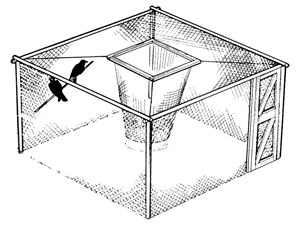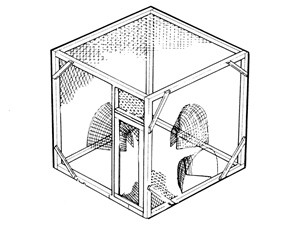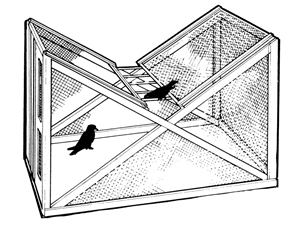Roof funnels
 This type of trap is particularly popular on the hill for carrion and hooded crow control. It can be made in sections, or permanently sited in places that are known to prove successful from year to year. The trap itself is usually about 3m square and 1.8m high, with a door in one side for access. It has a single roof-funnel entrance, which is 120cm square at the top, and framed with wood. This tapers to a round hole at the bottom, 60cm in diameter, and only about 22cm from the ground (see right). The idea is that the crow folds its wings to drop unrestricted down the funnel, but that if it spreads its wings to fly out again it does not have room even if standing exactly in the centre of the circle. Hence the height and diameter of the bottom of the funnel are more critical than the size at the top.
This type of trap is particularly popular on the hill for carrion and hooded crow control. It can be made in sections, or permanently sited in places that are known to prove successful from year to year. The trap itself is usually about 3m square and 1.8m high, with a door in one side for access. It has a single roof-funnel entrance, which is 120cm square at the top, and framed with wood. This tapers to a round hole at the bottom, 60cm in diameter, and only about 22cm from the ground (see right). The idea is that the crow folds its wings to drop unrestricted down the funnel, but that if it spreads its wings to fly out again it does not have room even if standing exactly in the centre of the circle. Hence the height and diameter of the bottom of the funnel are more critical than the size at the top.
Building such traps around a dead sapling or placing a perch which rises above the trap and leads a bird part way down the funnel are popular schemes, which seem to help. The trap is normally baited (with rabbits or other carrion) and left to work during the breeding season. The use of fallen farm stock as bait or food, such as dead lambs, is illegal under EU and UK Animal By-Products Regulations.
When cage traps are active, they must be inspected by the authorised person at least once every day at intervals of no more than 24 hours. Such an inspection must be sufficient to determine whether there are any live or dead birds in the trap. Any dead or sickly decoy birds must be immediately removed from the trap. Do not therefore rely on a binocular check. Remember that if using rabbit or other carrion as food for decoys, a multicatch cage trap may attract and catch non-target species such as buzzards. Birds other than those permitted for capture under licence must be released unharmed immediately on being found. It is a legal condition under General Licences that when not in use, multi-catch crow cages must be immobilised and rendered incapable of use. Access doors of multicatch cage traps must be removed from the site or securely padlocked open so that no bird can be confined.
The presence of a couple of live decoys (see legal section for legitimate decoy species) can enhance catches significantly and their care must comply to all relevant animal welfare legislation at all times, including the Animal Health and Welfare (Scotland) Act 2006. Decoy birds must be provided with adequate food, water and shelter and a suitable perch that does not cause discomfort to the birds’ feet. Decoy birds must also have adequate protection from the prevailing wind and rain. Appropriate shelter also helps during periods of hot sun through the provision of shade. In the uplands it is usually essential to stock-fence cages to prevent damage.
Ground level funnels
 This type of trap is usually made in sectional form for use on low ground. The standard, but not critical, size is a 1.8m cube. A ground level funnel similar to that on a pheasant catcher is put in three sides with a door in the fourth. The funnels should be about 50cm wide by 50cm high on the outside, tapering to 10cm wide by 12cm high at the inner end, with a length of about 60cm. Some keepers dislike this type of trap since it occasionally catches the odd gamebird.
This type of trap is usually made in sectional form for use on low ground. The standard, but not critical, size is a 1.8m cube. A ground level funnel similar to that on a pheasant catcher is put in three sides with a door in the fourth. The funnels should be about 50cm wide by 50cm high on the outside, tapering to 10cm wide by 12cm high at the inner end, with a length of about 60cm. Some keepers dislike this type of trap since it occasionally catches the odd gamebird.
The trap can be run in one of two ways. Either by introducing food, water, perches, shelter and several decoys as soon as it is set, or by pre-baiting. In the latter method no decoy is used and the trap is simply set up in an area where there are flock living corvids, with the roof off and the door removed from the site or taken off the trap and secured by a locked padlock. Bait is then scattered both around and within the trap for several days until the corvids are coming with confidence. White sliced bread is often as good a bait as any. It is palatable and visible, and if the wrappers are left in the trap the area resembles a picnic site. Once the bait is disappearing regularly, replace the door and fit the roof (a small piece of rearing-pen netting will do) and leave the trap for a full day. Catches in excess of 100 birds, particularly rooks and jackdaws, can be achieved in a single day in one trap.
Sometimes it pays to leave a few birds as decoys for a second day but in most cases it is better to return to pre-baiting for another week. Once catches fall off, it usually pays to move the trap to a new site.
Ladder letterbox traps
 This type of cage can be built to the same dimensions as the ground level or roof funnel types. It has no particular advantage, except that there is no risk of catching gamebirds. Its main disadvantage is when using it to trap jackdaws, which seem to have an ability to escape through roof entrances, although this design reduces that to a minimum. As will be seen from the diagram (left), the roof slopes from two sides to a central slot which has rungs across it like a ladder. The best size of slot is 14cm wide, with the rungs placed 9cm apart except for the centre which is 14cm square. The 30cm or so at each end should ideally be blocked off with plywood to prevent jackdaws from climbing up the sides and escaping.
This type of cage can be built to the same dimensions as the ground level or roof funnel types. It has no particular advantage, except that there is no risk of catching gamebirds. Its main disadvantage is when using it to trap jackdaws, which seem to have an ability to escape through roof entrances, although this design reduces that to a minimum. As will be seen from the diagram (left), the roof slopes from two sides to a central slot which has rungs across it like a ladder. The best size of slot is 14cm wide, with the rungs placed 9cm apart except for the centre which is 14cm square. The 30cm or so at each end should ideally be blocked off with plywood to prevent jackdaws from climbing up the sides and escaping.
Some keepers like to suspend 36cm lengths of line wire along both sides of the ladder at 30cm intervals to help prevent captive corvids flying up to the ladder once inside. Another variation of the letterbox design is to do away with the ladder rungs and simply suspend a one metre skirt of chicken wire from both sides of the ladder frame. With the wire skirts 14cm apart, larger corvids are unlikely to escape with their wings outstretched in flight.